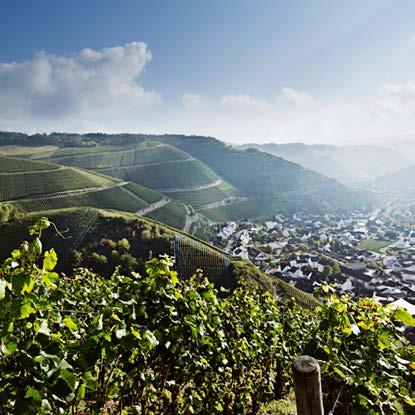
6 minute read
Ahr
PARADISE FOR PLEASURE SEEKERS
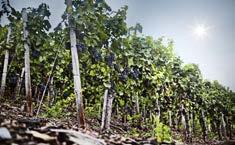
Advertisement
With about 560 ha (1,383 acres), the Ahr is one of the smallest and most northerly wine regions of Germany. Red grapes, in particular, thrive on the steep slopes overlooking the Ahr River.
even the romans appreciated the climatic advantages of the ruggedly romantic Ahr Valley and planted the first grapes here. The Ahr Valley, located in the northern portion of the state of rheinland-Pfalz, is known today as a red wine region. Specialties of the region include the “king of red grapes,” Spätburgunder (Pinot Noir), as well as Frühburgunder, an early ripening and highly esteemed mutation. The “Slow Food” organization actively seeks to protect such high-quality products. dedicated Ahr vintners are also interested in preserving vineyards planted with the rare Frühburgunder grape. It requires great effort to produce the region’s top wines. To care for and harvest their grapes, Ahr growers often have to clamber up craggy slopes, particularly to reach the many small terraces planted with only a few vines. Top-quality wines are the fruits of their labor. The Ahr river sleepily winds its way through the bizarre, rocky landscape of the valley toward the rhine. Vines cling to the barren cliffs. Grapes thrive here – the climate is relatively mild and at night, the stony soils release the warmth they’ve absorbed during the day.
wonderful hiking trails, carefully planned bike paths, and a diverse Nordic walking fitness park attract many tourists to the “Ahr, rhine, eifel” region. Most opt to hike along the picturesque “rotweinwanderweg,” a 35-km/22-mile-long trail through the vineyards from Bad Bodendorf to Altenahr that takes in all the wine villages en route. It offers spectacular views of the Ahr Valley throughout the year. Various descents and paths lead from the vineyard heights into the villages, where hungry and thirsty hikers can sample wines in vintners’ tasting rooms or with light fare in a Strausswirtschaft (casual wine pub). The wine and vacation region is prized for both its romantic, cozy settings as well as locales with outstanding wine and food. Cooperative wineries and wine estates stage all kinds of exciting events in historical buildings and in the vineyards. The region’s best chefs and top wine producers work together, not least at the very popular series of events known as “Gourmet & wein.” After a glamorous gala in January, the events afford gourmets and wine connoisseurs an absolute delight throughout the year, keeping in line with “well-Being 365” – the region’s motto. It’s also a pleasure to unwind at one of the numerous wine festivals and wine-related
cultural events, whether it’s the annual “weinmarkt der Ahr” at Pentecost or “LebensAHrt” or the “wine weekends” at harvest time that conclude with a brilliant firework display in the vineyards.
Information: Ahrwein e.V. Hauptstraße 80 53474 Bad Neuenahr-Ahrweiler Tel. +49 (0)2641 9171-0 Fax +49 (0)2641 9171-51 www.ahrwein.de info@ahrwein.de
Ahrtal-Tourismus Bad Neuenahr-Ahrweiler e.V. www.ahrtal.de info@ahrtaltourismus.de
AHR – AT A GLANCE
Geographical location: Southwest of Bonn; protected by the eifel Hills northwest of the region · Climate: Mild and favorable (Cologne Basin); partial greenhouse effect in steep sites · Soils: deep soils rich in loess in the Lower Ahr Valley; stony, partly slate and volcanic stone in the Middle Ahr Valley · Size: ca. 560 ha (1,383 acres) · Grape varieties: Spätburgunder (Pinot Noir), riesling, Frühburgunder (an early ripenening mutation of Spätburgunder)
Ahr: Landmarks of German Wine Culture
THE TASTING ROOM AT ROTWEINGUT JEAN STODDEN, AHR
The initials “JS” grace every bottle and barrel of Jean Stodden wine. The founder’s name is considered a personal warrant for the quality of each cask matured in the estate’s cellar in Rech. The current cellar master, Alexander Stodden, has remained true to the prized Spätburgunder (Pinot Noir) vines that thrive on the steep slopes of the Ahr Valley, proudly continuing a family tradition that stretches back to 1578.
The Initial Spark The physical design of an estate often gives clues on the owners’ philosophy about incorporating new ideas while continuing to preserve historical traditions. This went into the thinking when the Stoddens decided to convert
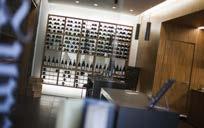
an old storage space into their new sales and tasting room. despite its modern design, a traditional warmth is maintained through the use of the natural elements of wood and stone. The architectonic design pays visual homage to the essential building blocks of the estate’s success: the walls are filled with wire baskets full of broken rocks from the vineyards, interspaced with oak paneling adorned with the traditional script of weingut Jean Stodden.
Jean Stodden – Das Rotweingut rech/Ahr, rotweinstraße 7–9 Tel. +49 (0)2643 3001 www.stodden.de
MAYSCHOSS – CRADLE OF THE WINEGROWERS COOPERATIVES, AHR
Craggy cliffs and steep, wildly romantic riverside vineyards accompany the Ahr on its path through the Rhenish Massif. The river carved itself an almost vertical channel through the stone – fully evident here in Mayschoß. On the terraced vineyards of the sunny south-facing vineyards, the slate soils heat up quickly by day. They store that warmth and return it to the vines at night. This unusual microclimate is perfect for worldclass red wines.
A Steep Climb! on 20 december 1868 Mayschoß became the cradle of a seminal new movement: 18 vintners met there that day to form the world's first wine cooperative. Their success did not go unnoticed, and by 1881 the winegrowing Association had swelled to 141 members. even today roughly 90 percent of all Ahr winemakers are organized into cooperatives. Mayschoß itself merged with Altenahr in
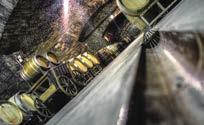
1982, becoming the Mayschoß-Altenahr winegrowers Cooperative. It currently counts 420 members cultivating 150 hectares (370 acres) of vines. Spätburgunder (Pinot Noir) is dominant here, covering 60 percent of the planted vineyards. riesling grows on another 20 percent. Average annual production totals 1.3 million bottles. The massive vaulted cellars are home to wooden casks with 300,000 liters of capacity, with steel tanks ready to hold another 1.6 million liters as needed.
Winzergenossenschaft Mayschoß-Altenahr Mayschoß, Ahrrotweinstraße 42 Tel. +49 (0)2643 93600 www.wg-mayschoss.de
MARIENTHAL MONASTERY NEAR DERNAU, AHR
It's been almost 900 years since 40 Augustinian nuns settled in this steep side valley of the Ahr. Dedicated to a pious life, the nuns arduously worked the surrounding parcels of land and planted vines on the precipitous slopes of the Hubach Valley. Although today only the picturesque walls of the cloister church remain, new life has recently taken root and begun to thrive.
Contrasting Pleasures Founded in 1137, the Marienthal Augustinian cloister was the first cloister in the Ahr Valley. over the course of centuries, it has suffered through blazes, plundering and war damage. Following the departure of the last of the nuns in 1802, the cloister fell into disrepair and was used in the 19th century as a quarry. Covered with ivy and wild grape vines, the ruins still tower over the small community of Marienthal, between walporzheim and
dernau.
In 2004 the Mayschoß-Altenahr winegrowers Cooperative, dagernova weinmanufaktur and the Meyer-Näkel and Brogsitter estates jointly founded weingut Kloster Marienthal. Today the church and cloister provide an atmospheric backdrop for concerts, festivals, tastings and other events. A staircase leads directly from the red wine Trail to the wonderfully arranged cloister garden.
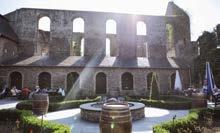
Winzergenossenschaft Mayschoß-Altenahr Mayschoß, Ahrrotweinstraße 42 Tel. +49 (0)2643 93600 www.wg-mayschoss.de
Dagernova Weinmanufaktur dernau, Ahrweg 7 Tel. +49 (0)2643 1266 www.dagernova.de
Weingut Meyer-Näkel/Ahr dernau, Friedenstraße 15 Tel. +49 (0)2643 1628 www.meyer-naekel.de
Brogsitter Weingüter, Privat-Sektkellerei, Exklusiv-Importe GmbH Grafschaft, Max-Planck-Straße 1 Tel. +49 (0)2225 918111 www.weingut-brogsitter.de










